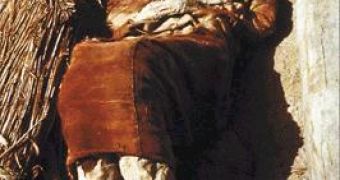China is the symbolic country for the Mongoloid race. But when Chinese researchers made a DNA analysis on the remains of a man found in a 1,400-year-old Chinese tomb, they found his genes were of an European. A white man.
The man's (named Yu Hong) tomb was found in Taiyuan (central China) and is the easternmost spot where the ancient European racial type has been found. "The [genetic group] to which Yu Hong belongs is the first west Eurasian special lineage that has been found in the central part of ancient China," said lead researcher Zhou Hui, head of the DNA laboratory of the College of Life Science at Jilin University in Changchun, China.
The tomb was discovered in 1999 and contained also the remains of an Mongoloid woman (or at least carrying Mongoloid genes). The tomb itself was typical for Central Asia, which at that time was inhabited by White people.
The people depicted in the tomb's carvings have European traits, like straight noses and deep-set eyes. "The mixture of different cultures made it difficult to confirm the origin of this couple, and the anthropologists also could not determine the race of these remains, owing to the partial missing skulls," Hui said.
Hui's team investigated their mitochondrial DNA, which is transmitted exclusively from mother to offspring. Yu Hong could have arrived in Taiyuan about 1,400 years ago and probably married a local woman.
The tomb's carvings display scenes from his life, and he could have been a chieftain of some Iranian Central Asian tribe who had settled in China during the Sui dynasty (A.D. 580 to 618). His grandfather and father could have lived in northwest China (Xinjiang region), being nobles of the Yu nation.
Yu Hong died in A.D. 592, at the age of 59 and his wife died in A.D. 598, being buried in the same grave. "The existence of European lineages in China was already known to us, but these lineages are mainly concentrated in Xinjiang province," Hui said. "In the central part of China, west-Eurasian lineages are seldom found in modern populations and have never been found in an ancient individual."
"However, it is impossible to draw conclusions about population movement into the region based on this one DNA sample. Was it just this one man [who moved into the area], or was it a large family including this man, or was it an even larger group of people from his ancestral population?" said Frederika Kaestle of the Indiana Molecular Biology Institute at Indiana University in Bloomington.
In fact, Western China was inhabited by blond-haired blue-eyed white people 3,000 years ago.
Archaeologists have discovered about 600 Caucasian mummies in Xinjiang Uygur Autonomous Region (West China), 2-3,000 years old. These mummies of the white people that once inhabited Western China were not embalmed, like the Egyptian ones were, but they were unwittingly preserved from decay by local climate: extreme summer heat and aridity, bitter winter cold, and salty soil. Those people, called Tocharians, left even a written language that is clearly Indo-European and which is close to the Iranian group.
And many old Chinese chronicles mention the contacts with red-haired people from the west. Even today, many Uigurs and neighboring ethnic groups - even if apparently Mongoloid - have blue eyes or red/blond hair...

 14 DAY TRIAL //
14 DAY TRIAL //